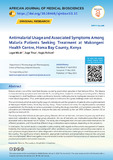Antimalarial Usage and Associated Symptoms Among Malaria Patients Seeking Treatment at Makongeni Health Centre, Homa Bay County, Kenya

View/
Date
2023-05-11Author
Lagat, Micah
Suge, Titus
Kagia, Richard
Metadata
Show full item recordAbstract
Malaria remains one of the most fatal diseases caused by plasmodium parasites in Sub-Saharan Africa. The disease
is characterized by symptoms and resemble the flu, including fever, headache, vomiting, and among others. Malaria
management in small healthcare centers continue to become challenging due to inadequate resources to invest in
more robust diagnostics. Thus, antimalarial prescriptions continue to be a great challenge under such situations.
The current study aimed at exploring the usage of antimalarials and the symptoms of patients who sought treatment
at Makongeni Health Centre, Homa Bay County, Kenya. Three hundred and ninety-five eligible patients completed
a questionnaire for the study on various parameters including the drugs prescribed, and symptoms presented. The
descriptive and inferential statistics to evaluate the data was achieved by the use SPSS software (version 25) at
significance level p≤0.05.
The study shows that individuals who were young, illiterate, did not use bed nets, and were not given any medication
were more vulnerable to malaria. Age group, education, the use of bed nets, and medications prescribed were all
associated with a decreased risk of malaria. The study also investigated how clinicians prescribed medications for
different symptoms, and it found that different drug combinations were employed depending on the symptoms.
In conclusion, the current study is a requisite in policy making with regards to the current management of malaria.
Evidently, the malaria symptoms may overlap with other conditions such as common cold and thus prescription on
such symptoms largely depends on other diagnostics which almost become challenging in small dispensaries across
the country. The significance of early detection, appropriate treatment, and preventative measures like using bed
nets are emphasized. More investigation is recommended in order to pinpoint the transmission of malaria and create
practical preventative and control measures.
